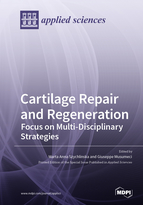Cartilage Repair and Regeneration: Focus on Multi-Disciplinary Strategies
A special issue of Applied Sciences (ISSN 2076-3417). This special issue belongs to the section "Applied Biosciences and Bioengineering".
Deadline for manuscript submissions: closed (20 October 2021) | Viewed by 18711
Special Issue Editors
Interests: anatomy; morphology; histology; musculoskeletal disorders; tissue engineering; cartilage regeneration; aging; nutrition; physical activity
Special Issues, Collections and Topics in MDPI journals
Interests: anatomy; histology; kinesiology; musculoskeletal disorders; sports medicine; cartilage; osteoarthritis; physical activity; aging; nutrition
Special Issues, Collections and Topics in MDPI journals
Special Issue Information
Dear Colleagues,
As widely demonstrated and known, adult articular cartilage exhibits a very poor self-healing capacity once injured. This is due to the complex multilayered morphological structure and an avascular, aneural, and hypocellular nature that characterize this tissue. A minimal damage or lesion may lead to cartilage tissue degeneration and osteoarthritis (OA) development, resulting in significant pain and disability.
Several approaches centered on cell-based therapies and cartilage engineering techniques have attempted to repair chondral or osteochondral defects that still remain a significant challenge in clinical practice. The failure in the use of these technics is often due to the improper mechanical properties of newly formed cartilage-like tissue, the early entrance of the lately differentiated chondrocytes in hypertrophic stage, characterized by a senescent-associated secretory-like phenotype, or the insufficient insertion into the host tissue, often characterized by the inflammatory, osteoarthritic milieu.
While several advances have been made in recent decades, the complexity and the multifactorial aspect of articular cartilage degeneration and a consequent, apparently unstoppable OA onset and progression suggest that a multidisciplinary approach will likely be optimal to address the challenge of preserving the articular cartilage in early stages and/or developing a functional cartilage replacements in advanced degenerative stages. This kind of approach is based on a combination of several disciplines, such as biomechanics and mechanobiology (bioreactors/moderate physical activity, etc.), innovative biomaterials functionalized with growth factors, exogenous enhancers and biomolecules exploiting pharmacological activities, cells from different sources (adult stem cells, chondrocytes, co-cultures), epigenetic modifications, functional foods, etc.
In the context of developing cartilage repair and regeneration strategies, this Special Issue’s Editor invites original contributions, review articles, communications, and concept papers that address these challenges. The suggested focus and the goal of a multidisciplinary strategy is to realize a clinically relevant tool for cartilage repair or regeneration that is more likely to be successful, obtained by controlling both the formation of a new suitable tissue replacements and the damaged joint tissues environment on the local and systemic level.
Dr. Marta Anna SzychlinskaProf. Giuseppe Musumeci
Guest Editors
Manuscript Submission Information
Manuscripts should be submitted online at www.mdpi.com by registering and logging in to this website. Once you are registered, click here to go to the submission form. Manuscripts can be submitted until the deadline. All submissions that pass pre-check are peer-reviewed. Accepted papers will be published continuously in the journal (as soon as accepted) and will be listed together on the special issue website. Research articles, review articles as well as short communications are invited. For planned papers, a title and short abstract (about 100 words) can be sent to the Editorial Office for announcement on this website.
Submitted manuscripts should not have been published previously, nor be under consideration for publication elsewhere (except conference proceedings papers). All manuscripts are thoroughly refereed through a single-blind peer-review process. A guide for authors and other relevant information for submission of manuscripts is available on the Instructions for Authors page. Applied Sciences is an international peer-reviewed open access semimonthly journal published by MDPI.
Please visit the Instructions for Authors page before submitting a manuscript. The Article Processing Charge (APC) for publication in this open access journal is 2400 CHF (Swiss Francs). Submitted papers should be well formatted and use good English. Authors may use MDPI's English editing service prior to publication or during author revisions.
Keywords
- cartilage repair
- cartilage regeneration
- tissue engineering
- multidisciplinary strategy
- osteoarthritis
- bioreactors
- mechanobiology
- physical activity
- functionalized biomaterials
- functional foods







